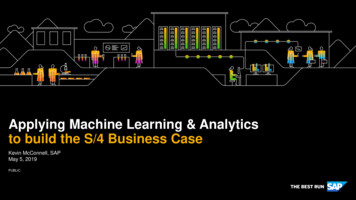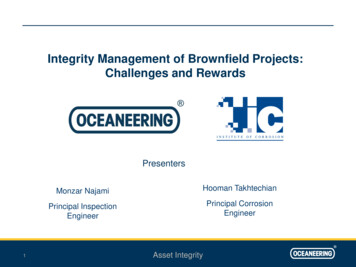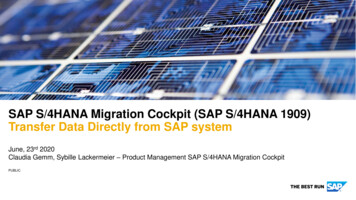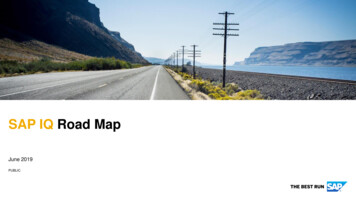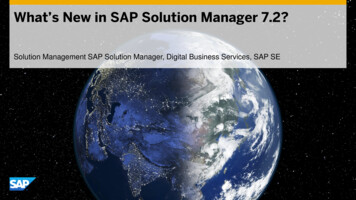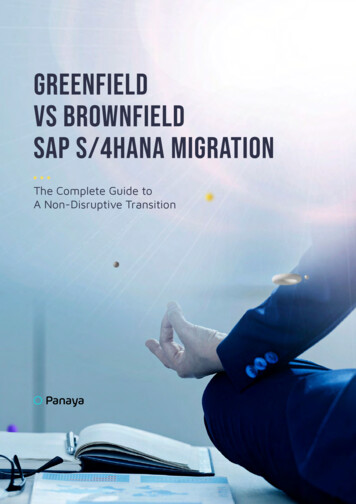
Transcription
Greenfieldvs BrownfieldSAP S/4HANA MigrationThe Complete Guide toA Non-Disruptive Transition
What'sinside3 Why SAP S/4HANA? Why Now?5 Greenfield vs Brownfield: All Things Considered6 Greenfield – A New Implementation7 Brownfield – System Conversion8 SAP S/4HANA Move: The Change Management Perspective8 How to Choose the Right SAP S/4HANA Migration Approach9 SAP’s Recommended Migration Strategy9 SAP S/4HANA Migration How-To2Greenfield vs Brownfield SAP S/4HANA MigrationSAP S/4HANA? Start Here »
Why SAP S/4HANA?why nowWith its flexible data structures, rich UI and real-time insights, SAP S/4HANA is a momentous release in SAP’shistory. According to an SAPInsider report, the main drivers which accelerates customer adoption are theopportunities for improving business operations presented by this next-generation release is the main driverfor acceleration customer adoption.SAP S/4HANA Migration: State of the MarketPanaya’s customer feedback shows that the SAP S/4HANA migration ship is definitely sailing, and everyonewants to be on it. Our findings are on a par with those of a SAPinsider recent report. According to theSAPinsider survey, 52% of organizations are currently in the evaluation phase of their SAP S/4HANAmigration.Here are just some of the insights we gathered from talking to customers in different industries, like;consumer goods, retail, manufacturing, and pharmaceuticals: Most organizations are taking the System Conversion (Brownfield) path to SAP S/4HANA A major pain point is the evaluation (business case) phase Project scope, resources, and timeline are difficult to evaluateWho Is Moving to SAP S/4HANA?An ASUG survey further identified a few characteristics for organizations that have started to make themove: They tend to be early tech adopters who can make IT-led business cases. They’ve had to make a business case around external IT factors, such as a merger or acquisition. Or, they’ve needed to do a system refresh and see the move as an opportunity.SAP S/4HANA Migration - Where to Start?Use Value Stream Management to realize your IT priorities. Allocate resources based on added value tothe end-user experience. Do not automatically assume your most challenging projects are also the mostimpactful ones.Start building a viable business case well ahead of your move. This may sound obvious, but apparentlysome organizations could use a reminder.Waiting for the last minute means you will have to pay the cost of indecision; technical debt, market shareloss to competition and eventually, a rushed, insufficiently resourced migration project.3Greenfield vs Brownfield SAP S/4HANA MigrationSAP S/4HANA? Start Here »
52%St ar t building a v iablebusiness case well ahead ofyour move. This may soundobvious, but apparently someorganizations could use areminder.Over 52% are currentlyin the evaluation orpilot phase of theirSAP S/4HANA migration.Waiting for the last minutemeans you will have to pay thecost of indecision; technicaldebt, market share loss tocompetition and eventually,a r ushe d, insuff icientlyresourced migration project.Organizations' SAP S/4HANA Adoption Strategy41%21%11%12%7%4%No plansyet – likelyto considerwithin 12months44%No plansyet – likelyto considerwithin 24monthsCurrentlyevaluatingGreenfield vs Brownfield SAP S/4HANA MigrationPilot projectunder wayCurrentlyimplementingAlreadyusingNo plansSource: SAPinsider , April 2019SAP S/4HANA? Start Here »
Greenfield vs Brownfield:All Things ConsideredThere is no single solution when it comes to SAP S/4HANA migration, and each organization is in a differentstage of SAP S/4HANA readiness. Some have chosen the Greenfield approach, which means implementing anew system. Others have chosen the Brownfield approach or, System Conversion, because it doesn’t disrupttheir existing business processes. And for those who wish to consolidate their current system landscape intoSAP S/4HANA, there’s landscape transformation.According to the SAPinsider survey report, SAP S/4HANA: State of the Market, ‘31% of companies overall areplanning a “lift and shift” (Brownfield) approach. These companies want to preserve their existing investment and the customization of their business processes and are looking for the easiest, least disruptive pathforward.SAP S/4HANA Implementation UnsureOtherSource: SAPinsider , April 2019As each methodology has its advantages and challenges, you must take a look at your database,platform, and configuration before deciding which route may be most suitable to your given situation.Below, we analyze each methodology to help you do just this.5Greenfield vs Brownfield SAP S/4HANA MigrationSAP S/4HANA? Start Here »
Greenfielda new implementationThe Greenfield approach means a new implementation of SAP S/4HANA. On the bright side, it enables completere-engineering and process simplification. The Greenfield approach lets organizations predefine migrationobjects and best practices. It lowers Time-to-Value and TCO and facilitates faster adoption of innovationwith SAP S/4HANA capabilities.On the downside, a Greenfield implementation can be a time-consuming project, especially on the changemanagement side, since you have to start everything from scratch.As an SAP manager, going through the re-implementation route can be unnerving. Your SAP system isexpected to operate entirely different but you are unsure as to what exactly will change. Finally, a Greenfieldimplementation in and of itself does not guarantee that the newly implemented system will be operational.Organizations choosing this approach will need to allot time for adjustment.End of SAP ECC SupportYour vanilla S/4 system goes live with(some) capabilities that (may or maynot) match business needsFinished? Hold your breath, cross yourfingers and (optionally) pray for a smoothgo-liveBuild new system – run – then mitigate risk –run – test - Repeat.Store and manage the retiredprocesses and dataRewrite your systemcustomizationsConfigure your vanillaS/4 system from scratchRedesign your businessprocesses according to the S/4standardRetire all businessprocessesGreenfield Means Starting from ScratchNew deployment. New system. New processes. New everything!6Greenfield vs Brownfield SAP S/4HANA MigrationSAP S/4HANA? Start Here »
Brownfielda new implementationSystem conversion, also known as the Brownfield approach, enables migration to SAP S/4HANAwithout re-implementation and without disruption to existing business processes. At the same time,it enables the reevaluation of customization and existing process flows.System conversion is about moving your entire SAP system and business processes to a newplatform of SAP S/4HANA. This approach is preferable if you’d like to avoid any changes to yourbusiness processes. It allows you to run your business with less disruption since it’s more of atechnical system conversion. The downside is that possible issues on the technical side can arise,but with the right tools and technology, like Panaya S/4 Convert, the risk can be mitigated.For organizations aiming to keep their investments in their current ECC, a system conversion is thepreferred approach. Panaya S/4Asses provides the certainty and ease you need to start your SAPS/4HANA migration, including valuable insights and a detailed report.Landscape TransformationLandscape transformation is a derivative of the Brownfield approach. Through landscape transformation,you can selectively migrate parts of your business process to SAP S/4HANA or consolidate your businesslandscapes into one global system. This means that you can first select the process that gives you thebest—and fastest—ROI to be migrated to SAP S/4HANA. Customers may choose to go down this route,for instance, when adopting SAP S/4HANA capabilities for Central Finance.Landscape Transformation Use Case: Central FinanceThe components architecture surrounding SAP S/4HANA allows organizations to implement a standalone business process linked to SAP S/4HANA’s ERP core system. One example of this is SAP CentralFinance. With landscape transformation, you can utilize SAP Central Finance by migrating your financialpostings to the HANA database. It uses the single database table called Universal Journal for all data fromGeneral Ledger, Profitability, Management Accounting, Asset Accounting, and Material Ledger. This newarchitecture allows you to produce a multidimensional financial reporting structure by incorporating thedata from your legacy systems into Central Finance without any data duplication.Using this function of Central Finance, you can still perform the financial postings in your legacy systemwhile the data is being replicated into the Universal Journal entry database via the SAP LandscapeTransformation Replication Server. This means that you can gradually move the process, piece by pieceinto the new SAP S/4HANA before completely turning off the old system. This reduces the risk of replacingmany different systems all at once.7Greenfield vs Brownfield SAP S/4HANA MigrationSAP S/4HANA? Start Here »
SAP S/4HANA Move:The Change Management PerspectiveAn SAP S/4HANA migration is not only a technical challenge. It also touches and affects nearly everybusiness unit. From a change management perspective, a Greenfield implementation project is amajor undertaking.Organizations are daunted by the uncertainty regarding the scope of potential change caused by areconstruction of the entire SAP environment.As opposed to a full migration, with system conversion, IT professionals and users can build on existingelements of the SAP environment, as well as on satellite systems such as supplier and partners’systems. The gradual approach minimizes delays and disruption caused by testing to mission-criticalapplications.Change managers can take time and adjust the migration-pace based on available budget and marketconditions (e.g., development freeze during busy season). Additionally, a step-by-step migration allowsfor more leverage of business users' experience.How to Choose the RightSAP S/4HANA Migration approachChoosing the right approach requires that an organization performs extensive analysis and evaluationof both technical and functional aspects. The existing system landscape, business function, and userreadiness are a few things that need to be taken into consideration. More importantly, you shouldtake a look at your own roadmap for digital transformation. That is, identify where you are and whereyou want to go in the upcoming years.Key Points to Help You Decide Which Path to Take for Your SAP S/4HANA Migration8What Are You Looking For?Path to TakeSimplification of current business processesGreenfieldA quick transformation into the new SAP S/4HANA systemGreenfieldConverting your current SAP ERP system into SAP S/4HANABrownfieldSelective migration, such as for a certain business processor organizational unit. Consolidation of multiple systems,both SAP and non-SAP, into one global systemLandscape TransformationGreenfield vs Brownfield SAP S/4HANA MigrationSAP S/4HANA? Start Here »
SAP's RecommendedMigration strategySAP users deliberating the migration process often wonder what SAP’s official recommendationis. The Brownfield route is endorsed and recommended by SAP for existing customers that wish tomigrate to SAP S/4HANA while still capitalizing on their SAP ECC investment.In a recent interview, Rudolf Hois, SAP VP and chief product owner for SAP S/4HANA was quoted sayingthat 50-60% of the SAP S/4HANA install base has already chosen system conversion as their route. Infact, to accommodate this route’s growing popularity, the latest version, SAP S/4HANA 1809, simplifiesand improves automation and downtime for system conversion. Mr. Hois also shared lessons learnedon different implementation projects. He noted that the route chosen for SAP S/4HANA migration isreally dependent on the Change Management methodology a given organization can afford.SAP S/4HANA Migrationhow toOnce the path has been decided upon, it’s time to prepare for the actual migration by planning theexact steps needed for a successful implementation.Greenfield: Step by StepIf Greenfield is your method of choice, the ‘SAP Activate’ is an Agile methodology that can assist you.Here it is in 6 simple steps:The ״ SAP Activate ״ The first step is to identify the value of your business and then develop the roadmap and strategy to be used inthe implementation of the project.PrepareIn this phase, you initiate and start working on your final project plans as well as preparing your team. Choosingthe right people for your team is essential to ensure the project will run optimally.ExploreSAP S/4HANA offers a wide range of solutions for your business, especially for a new implementation. In thisphase, the scope evaluation process will be performed, and a Fit / Gap analysis can be adopted—instead oftraditional blueprint requirements—in order to ensure a more efficient and faster implementation.Realize9PrepareThis phase focuses on the realization process of the business requirements that have been defined in theprevious phase. These include system configuration settings, integration scenarios, and data migration.DeployThe production environment is set up in this phase. When it’s ready, cutover activities will be performed andbusiness operations are moved to the new system.RunGo live with your new SAP S/4HANA system!Greenfield vs Brownfield SAP S/4HANA MigrationSAP S/4HANA? Start Here »
Brownfield: Step by StepThe Brownfield migration process is divided into two phases: preparation and realization.Preparation PhaseSystemRequirements& PlanningConversionPre-CheckRealization PhaseCustomCodeMigrationSystemInstallationFollow - OnActivitiesPreparation Phase System Requirements & Planning: This assessment should be conducted to analyze theexisting system and then define the best possible solution to execute the migration. Conversion Pre-Check: A compatibility check of any add-ons or business functions thatare active in the current system is required to ensure they can technically be convertedinto SAP S/4HANA. Consult SAP’s Simplification Item Check to identify the mandatory steps beforeconverting your system. Custom Code Migration: Take this step to check your custom code against SAP S/4HANA compatibility.This is essential, especially if there are enhancements in your current system.Realization Phase System Installation: After the preparation phase, you can star t the conversion to SAPS/4HANA. This step includes database migration and data conversion. Follow-On Activities: After the technical conversion, all relevant customized settings mustbe migrated. Data Consistency Check (especially for financial data): Since SAP S/4HANA collects all relevantcomponents from Financial Accounting (FI) and Controlling (CO) into one data pool, called the UniversalJournal, it is imperative that you perform reconciliation between your accounting components. In thisway, the data can be merged correctly into the Universal Journal. Iteration Testing: When all customization has been performed and all data have been migrated, youmust run test iterations for final business process validation.10Greenfield vs Brownfield SAP S/4HANA MigrationSAP S/4HANA? Start Here »
If you've already decided on migrating to SAP S/4HANA and are struggling to choose yourpath, Panaya's Assessment Pack can help you decide. With a comprehensive analysis of yourECC landscapes, Panaya can show you upfront the potential of System Conversion effortssavings, based on both standard and custom code SAP S/4HANA impact.SAP S/4HANA? START HERE!Panaya’s Change Intelligence platform enables organizations to understand the impact of every potential change to their ERP or CRM, so they innovatequickly, safely, and without fear. With Change Intelligence, companies gain deep, granular insight into each upgrade, update or added feature downto the code-level. They understand exactly what, where, and how to test so they deploy more efficiently. And they get precise,change-by-change directions, allowing them to continuously innovate at the pace of today’s business. With offices in theUS, France, Germany, Japan, and Israel, Panaya is helping over 3000 leading enterprises worldwide change with confidence.panaya.comGreenfield vs Brownfield SAP S/4HANA Migration
The components architecture surrounding SAP S/4HANA allows organizations to implement a stand-alone business process linked to SAP S/4HANA's ERP core system. One example of this is SAP Central Finance. With landscape transformation, you can utilize SAP Central Finance by migrating your financial postings to the HANA database.



